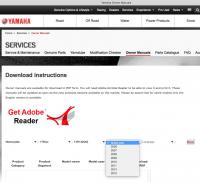mcatrophy
Privileged to ride a 2018 FJR1300AS
A tangent from a discussion Fred W and I were having in another thread about when the YCC-S version of the FJR (FJR1300AE in the USA, FJR1300AS in the UK) was really made.
The "AS" model has been on sale in the UK all years since its 2006 introduction, however their web site now shows specifications for years 2010, '13, '14, '15 and '16.
Downloads for the Owner's Manuals also miss out 2012 and 2014:
Web page Blow-up of year list


That may reflect when changes were made to the specification even if only colours - we never had the 81 mph cruise control restriction on our '13
 .
.
In the USA the VIN must contain the date code. This is not mandated in the UK and my VINs don't show the dates. However, I firmly believe my '10 was assembled in 2010. When I took the front mudguard off to fit an extender, I could see the date mark from the mould. The margins show year dates labeled "06 07 08 09", months 1 to 12, all this in a matrix. There is a punch mark in the place where January '10 would be if the original mould date matrix had had the marking for that year. Just about visible in the picture below (very difficult to photograph black marks in black plastic
 ).
).
(Click on image for larger view)

I saw other similarly stamped date codes on other pieces of plastic, but not photographed.
I can't say what year my '14 was made, it may well be a left-over '13. Next time I have any plastic off, I'll look for the date mark.
As for 2016, it's shown on the UK site without a price, but it is shown on the Netherlands site priced at €22499 (a little over £17000 or $24580 at today's rates), so presumably they've made some 2016's.
I've been updating every 4 years, not from any "rule", simply a coincidence in our situation. However, I suspect I won't be changing mine for a 2018 whether or not it's still available, simply because of my birthday count
 .
.
I agree about the marketing failure bit, it has never sold well here (the 'A' version isn't exactly a big seller, the 'AS' is even worse).I am not sure that what you say is true. I recall that there are different "rules" for what constitutes a particular model year in various countries, and that "left-overs" can be sold as a current model year in some.Fred, they never stopped making them. I had a new one in 2010 and another in 2014. They merely stopped importing them into America. They are showing them on the European web site for 2016 as well.That was also the point in time when they decided to quit making an auto clutch version.
T
Coincidence?
And no, I'm not just being a US-centric snob here. I really do believe that Yamaha pulled the plug on the AE (or whatever letters denote the auto clutch version in your location) because it was a dismal marketing failure. That is not to say that there was anything particularly wrong or bad about the design. Just that the marketing/sales dweebs failed to convince the masses that this was what they wanted, and it ended in a bad financial accounting.
The "AS" model has been on sale in the UK all years since its 2006 introduction, however their web site now shows specifications for years 2010, '13, '14, '15 and '16.
Downloads for the Owner's Manuals also miss out 2012 and 2014:
Web page Blow-up of year list


That may reflect when changes were made to the specification even if only colours - we never had the 81 mph cruise control restriction on our '13
In the USA the VIN must contain the date code. This is not mandated in the UK and my VINs don't show the dates. However, I firmly believe my '10 was assembled in 2010. When I took the front mudguard off to fit an extender, I could see the date mark from the mould. The margins show year dates labeled "06 07 08 09", months 1 to 12, all this in a matrix. There is a punch mark in the place where January '10 would be if the original mould date matrix had had the marking for that year. Just about visible in the picture below (very difficult to photograph black marks in black plastic
(Click on image for larger view)

I saw other similarly stamped date codes on other pieces of plastic, but not photographed.
I can't say what year my '14 was made, it may well be a left-over '13. Next time I have any plastic off, I'll look for the date mark.
As for 2016, it's shown on the UK site without a price, but it is shown on the Netherlands site priced at €22499 (a little over £17000 or $24580 at today's rates), so presumably they've made some 2016's.
I've been updating every 4 years, not from any "rule", simply a coincidence in our situation. However, I suspect I won't be changing mine for a 2018 whether or not it's still available, simply because of my birthday count





